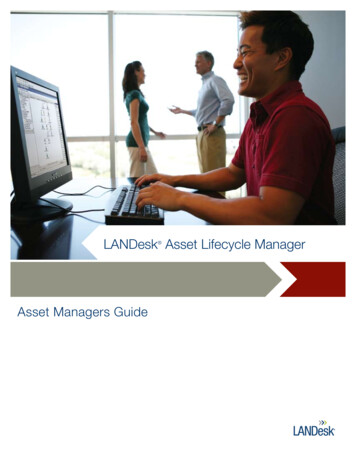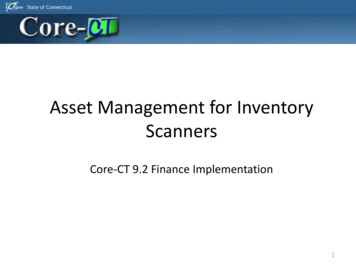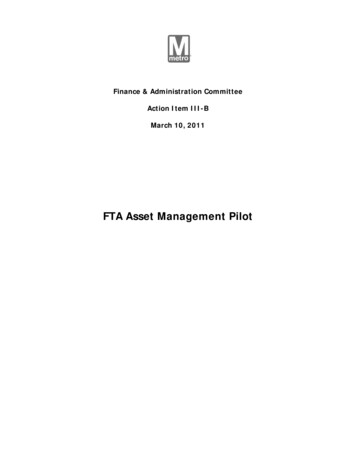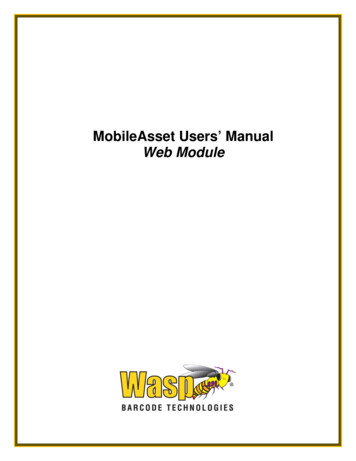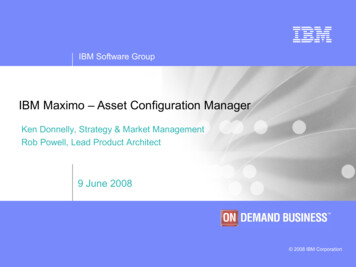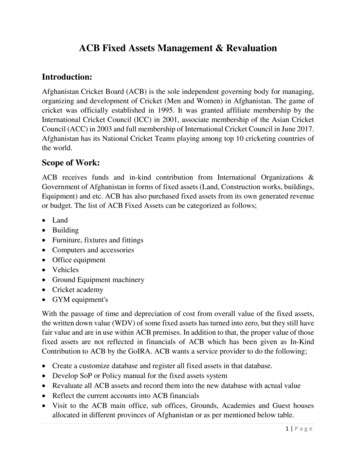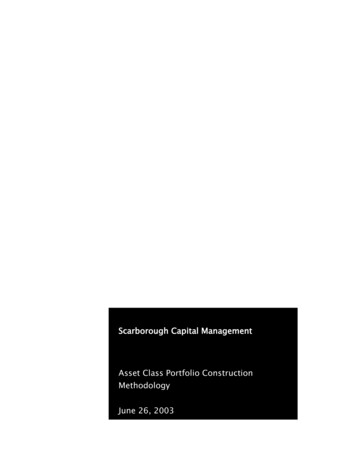
Transcription
gepower.comGE DigitalAsset ManagementTraining ril 2022
Copyright 2022 General Electric Company. All Rights Reserved. GE and the GE Monogram are trademarks andservice marks of General Electric Company.The Software Product described in this documentation may only be used strictly in accordance with theapplicable written License Agreement. The Software Product and Associated Documentation aredeemed to be “commercial computer software” and “commercial computer software documentation,”respectively, pursuant to DFAR Section 227.7202 and FAR Section 12.212, as applicable, and are licensedwith Restricted Rights as identified in the License Agreement, and as set forth in the “Restricted RightsNotice” contained in paragraph (g) (3) (Alternate III) of FAR 52.227-14, Rights in Data - General, includingAlternate III (June 1987).The information contained in this online publication is the exclusive property of General ElectricCompany, except as otherwise indicated. You may view, copy and print documents and graphicsincorporated in this online publication (the “Documents”) subject to the following: (1) the Documentsmay be used solely for personal, informational, non-commercial purposes; (2) the Documents may notbe modified or altered in any way; and (3) General Electric Company withholds permission for makingthe Documents or any portion thereof accessible via the Internet. Except as expressly provided herein,you may not use, copy, print, display, reproduce, publish, license, post, transmit or distribute theDocuments in whole or in part without the prior written permission of General Electric Company.The information contained in this online publication is subject to change without notice.The software described in this online publication is supplied under licence and may be used or copiedonly in accordance with the terms of such licence.TrademarksAdobe, Acrobat and Reader are either registered trademarks or trademarks of Adobe SystemsIncorporated in the United States and/or other countries.Citrix and Citrix MetaFrame XPe are trademarks or registered trademarks of Citrix Systems, Inc. in theUnited States and other countries.IBM and WebSphere are trademarks of International Business Machines Corporation in the UnitedStates, other countries, or both.InstallShield is a registered trademark of Flexera Software, Inc. in the United States and/or othercountries.Intel and Pentium are registered trademarks of Intel Corporation.Microsoft, Windows, Excel and Access are either registered trademarks or trademarks of MicrosoftCorporation in the United States and/or other countries.Oracle and Java are registered trademarks of Oracle Corporation and/or its affiliates. Other names maybe trademarks of their respective owners.UNIX is a registered trademark of The Open Group in the US and other countries.Other company or product names mentioned in this documentation may be trademarks or registeredtrademarks of their respective companies.Page 2Enquiries: mailto:education.services@ge.com
ContentsAsset Management Training . 5Training as Part of a Project Delivery . 7Smallworld Core Spatial Technology Courses . 9CST001: Foundation Course . 9CST002: Magik Programming Course .10CST003: Application Development Course .11CST004: Fast Track Course .12CST005: Getting Started with Smallworld .13CST006: Administration Course .14CST007: Upgrade to 5 Course .15Smallworld GeoSpatial Analysis Courses .16GSA001: GeoSpatial Analysis User & Configurer .16GSA002: GeoSpatial Analysis Web User .17GSA003: GeoSpatial Analysis Web Configuration.18Smallworld Network Inventory Training Courses .19SNI001: Telecoms Strategic Planning & Analysis .20SNI002: Telecoms Network Design and Planning .21SNI003: Network Build and Construction .22SNI004: Post Build Updates .23SNI005: Network Operations .23SNI006: Network Maintenance.24SNI007: System and Database Administration .25SNI008: Application Configuration and Administration .25SNI009: Telecoms Update to 5 for Expert Users .25Page: 3Enquiries: mailto:education.services@ge.com
Mobile Enterprise Courses .26MES001: Getting Started with Mobile Enterprise .26MES002: Mobile Enterprise Development using the SDK .27Smallworld Electric Office Training Courses .28EOS011: Electric Office Commercial Positioning .28EOS012: Electric Office Technical Functionality .28EOS001: Electrical Network Strategic Planning & Analysis.29EOS002: Electrical Network Design .30EOS003: Electrical Network Build & Maintain .31EOS004: Electric Office System & Database Administration .32EOS005: Electric Office Application Configuration and Administration .32Gas Distribution Office Courses .33GDO001: Gas Distribution Network Strategic Planning.33GDO002: Gas Distribution Network Design .34GDO003: Gas Distribution Office Configuration & Administration Course .35Global Transmission Office Courses .36GTO001: Global Transmission Network Strategic Planning.36GTO002: Global Transmission Office User Course .37GTO003: Global Transmission Office Configuration & Administration Course .38Page 4Enquiries: mailto:education.services@ge.com
Asset Management TrainingIntroductionEducating staff to properly operate, configure and maintain information systems is key torealising the productivity gains achievable from new technology. GE Digital’s training is a serviceoffering designed to assist clients in applying our applications as effectively as possible.We offer a wide range of technical training courses relating to products in the GeoSpatial AssetManagement portfolio. These courses are available on-line or in a traditional classroom formatat GE Digital training facilities or customer sites. Training is provided by subject matter experts(SMEs) in specialized areas including core geospatial software, utility applications,telecommunications network inventory management and mobility solutions.Training formats include e-learning, webinars or traditional classroomOur standard courses are scenario-based using the off-the-shelf products configured withexample databases. We can also provide bespoke training in which we adapt our materials inline with customers business processes and available data. Our consultants will work closelywith key users to identify appropriate scenarios as a basis for the materials. This is generallyaccepted as the best means of providing high quality, relevant training.gepower.comPage: 5Enquiries: mailto:education.services@ge.com
GE Digital offer training in a variety of formats:In a ClassroomGE Digital has a number of dedicated training centres with fully equipped classroomfacilities. Classroom courses are either open, in which case they are made available tothe entire customer and partner base, or private for a particular customer often usingbespoke training materials for a larger group of users.Customers may have their own classroom facilities in which case our trainers areprepared to travel to present the course. Customers should note that the classroom willrequire at an installed training environment for the practical sessions - typically amachine per attendee.Online as a series of webinarWebinar or remote learning is flexible, quick to set up, low cost and has the advantage ofminimising disruption to staff schedules.Our webinars consist of a series of remote sessions over Skype, Teams or Webex –typically presentations and demonstrations in the mornings leaving students to practiceexercises in the afternoons. Course attendees are provided with a pre-installed virtualmachine for the practical sessions.Online as eLearningSome courses are available in an eLearning format accessed through our LearningManagement System. This is self-paced training consisting of a series of interactivepresentations and videos used to teach the theory and incorporating hands-on practicalexercises. We offer a package which includes a pre-installed virtual machine and a tutorto assist or answer questions should the need arise. You can pause taking the course atany time and return to it later over a period of 30 days and opt for a test at the end.Information on training can be found on our ion-servicesFor pricing or to enquire about other courses and training options, send an email toeducation.services@ge.comPage 6Enquiries: mailto:education.services@ge.com
Training as Part of a Project DeliveryTraining is typically a stage in one of our implementation projects rooted on GE’s SoftwareSolutions Delivery Methodology; a set of tools and processes to develop new products quickly,achieve better outcomes for our customers, and drive quality and competitive advantage. Byusing these new set of tools GE Digital aims to deliver the right solution faster, within budgetand with a quicker return on investment for our customers.For bespoke user training we review with our customers how they plan, design, build, optimiseand roll out network infrastructures against a set of industry recognised business processes.These business processes have been created by GE Digital over 20 years of working with morethan 350 global utility and telecommunications customers.These business processes form the backbone of the solution delivery, with all aspects ofconfiguration, testing and training aligned to ensure the solution delivery matches thecustomers’ business practices. The adoption of this approach maximises scope within costconstraints whilst successfully implementing next generation technologies with increasedorganisational efficiency.GE Digital asset management solutions are internationally known and widely used in theplanning, construction and maintenance of complex network infrastructure. GE has a large arrayof industry standard out-of the-box technologies, which can be combined to build an end to endsolution, closely aligned to a customer’s business needs. Much of our solution is preconfiguredto meet the majority of our customer’s business processes, and acts as a documented baselinefor solution enhancement; reducing extensive and costly customisation as well as reducing thetime to recover the value of implemented solutions.Page: 7Enquiries: mailto:education.services@ge.com
GE Digital’s solution offering includes industry market leading technology such as:Geospatial Asset Management: Market leading solution suite that provides geospatialasset management for utilities and telecommunication providers to support networkplanning, design and analysis, maintenance and operations.OMS and DMS integration: A configurable standards-based software solution that providesutilities with an automated way of introducing the electric network to the OMS (OutageManagement System) and DMS (Distribution Management System) via CIM (CommonInformation Model).Business Intelligence: A state of the art map-centric business intelligence suite providingcomplete, fast, relevant, actionable insight to all those involved in the enterprise.Mobile Solutions – Suite of offline and web-based work force management tools that allowcompanies to optimize the full life cycle of field service operations.Web Solutions – A range of simple, easy–to-use business applications for customers todeploy, working in tandem with the enterprise engineering applications.Best in Class Delivery MethodologySuccessful delivery of projects can beattributed to a structured, governedand repeatable project managementmethodology. Here at GE Digital, weare firmly grounded in industrystandard project managementprinciples which act as a frameworkto optimise solution deliveries. Theapplication of the principlessignificantly reduces uncertainty andsupports our customer’s goal of adelivered solution; on time, withinbudget and to agreed quality criteria.GE Digital services projects aredelivered over 10 stages. Each stagehas clear stage boundary controlswhich deliver flexible decision pointsthroughout the project execution.Right PeopleAll of GE Digital consultants have strong domain and technology knowledge, allowing us towork closely with key stakeholders within our customers businesses and develop trulyinnovative solutions. We collaborate with our customers throughout the planning, design, andimplementation of the adopted solution and build strong connections into the customerbusiness. Post implementation, we provide business centric training and ‘go live’ support toensure a smooth transition from legacy systems to the customer new solution. With a globalbody of GE Digital consultants and accredited partners, we are able to truly serve a diverseglobal client base with a strong local presence.Page 8Enquiries: mailto:education.services@ge.com
Smallworld Core Spatial TechnologyCoursesCST001: Foundation CourseDescriptionThe Foundation Training course provides a general overview of various parts of Smallworld Core SpatialTechnology. Most of the topics described in this course are covered in much greater depth in otherspecific training courses.ObjectivesHaving attended this course, attendees will Be familiar with using Smallworld Core as auser. Gain a basic knowledge of how to configure theuser environment for Smallworld applications. Understand the main functions of databaseadministration. Explore some basic Smallworld Magikcommands and create some Magik objects. Know the product portfolio.Topics IntroductionUsing Smallworld Core SpatialTechnologyGetting StartedUpdating InformationAnalysing DataUsing Layouts and PlottingConfiguring the user environmentDatabase administrationData modellingIntroduction to MagikProduct PortfolioWho should attend?Anyone who requires an overview of Smallworld Core, such as users, configurers, databaseadministrators, data modellers, developers of Smallworld applications, managers and prospectiveSmallworld customers.Duration: 2 daysAvailable formats: Classroom, Webinars or eLearningProducts Required: CST 5 configured with Cambridge DatabasePage: 9Enquiries: mailto:education.services@ge.com
CST002: Magik Programming CourseDescriptionThe Magik Training course provides an introduction to the Magik language and some of the systemobjects defined in Smallworld Core. It introduces the structure of an installed product and thecustomisation of an application — that is, making small changes in existing functionality and userinterface. It also introduces Java and Magik interoperability.ObjectivesHaving attended this course, attendees will have A knowledge of Magik syntax. An understanding of the concepts underlying object-oriented programming. Ability to write, compile and debug Magik code. An understanding of classifying methods and classes using pragma statements. Knowledge of the physical architecture of the Smallworld system and key objects. An understanding of how resources are used in a session The ability to provide additional resources to customise a user interface. Understand Java and Magik interoperability. Experience of using the Class Browser.Topics Core Product System Rationale Debugging Magik LanguageObject Orientation and Magik ObjectsObject InheritanceCollection ClassesAccessing the Database Graphical User Interface in MagikProduct StructureDevelopment ToolsMagik - Java interoperabilityTopologyWho should attend?Software engineers who are following the full Smallworld customisation programme.Prerequisites Smallworld Core Spatial Technology Foundation Training (course CST001) A minimum of two years' experience with a procedural or object-oriented programminglanguage such as C or JavaDuration – 3 daysAvailable formats: Classroom, Webinars or eLearningProducts Required: CST 5 configured with Cambridge DatabasePage 10Enquiries: mailto:education.services@ge.com
CST003: Application Development CourseDescriptionThe Application Development Training course introduces the development of customised applicationsbased on Smallworld Core Spatial Technology.ObjectivesHaving attended this course, attendees will have Developing an application based on Smallworld Core, with interactive access to the functionality. Configuring the user interface to an application, to include providing alternative ways ofaccessing existing functionality and providing access to new functionality. Advanced aspects of the Magik language necessary for controlling an application. Advanced techniques for accessing datasets in a Smallworld database, including loading data,creating geometry, and storing it in a dataset. Customising the Style system for user objects and geometry types. Creating a new database and defining the data model for a Smallworld dataset, including custombehaviour for user objects.Topics Product Structure Accessing and Updating User data SessionsSmallworld Framework ArchitectureInterfacing Core PluginsGraphical User InterfaceThreadsXML Data Loader Understanding the Spatial ContextsCustomizing the Style SystemMagik ControlCreating a databaseMethods for the data modelDevelopment ToolsWho should attend?The course is intended for software engineers who are following the full Smallworld customisationprogramme.Prerequisites Smallworld Core Spatial Technology Foundation Training (course CST001) Smallworld Core Spatial Technology Magik Training (course CST002) A minimum of two years' experience with a procedural or object-oriented programminglanguage such as C or JavaDuration – 5 daysAvailable formats: Classroom or WebinarsProducts Required: CST 5 configured with Cambridge DatabasePage: 11Enquiries: mailto:education.services@ge.com
CST004: Fast Track CourseDescriptionA 10 day course ideal for those wanting an introduction to the Smallworld product suite and likely to beinvolved in project delivery including configuration, administration and application development.ObjectiveThis course consists of the three standard courses (Foundation, Magik, Application Development) run inseries. See the descriptions for these individual courses for details. Note that the Magik Programmingcourse is also available in eLearning format as an alternative to the classroom.TopicsMost of the modules included in the Foundation, Magik Programming and Application Developmentcourses will be covered in this fast-track course.Who should attend?The course is intended for software engineers who are following the full Smallworld customisationprogramme.Duration – 10 daysAvailable formats: Classroom or Webinar (Foundation and Magik parts also available as eLearning)Products Required: CST 5 configured with Cambridge DatabasePage 12Enquiries: mailto:education.services@ge.com
CST005: Getting Started with SmallworldDescription:A 5-day course for those new to Smallworld introducing the product suite and covering its use plus abasic introduction to Magik programming and Application Development.ObjectiveHaving attended this course, attendees will have Familiarity with using Smallworld Core as a user Knowledge of Magik syntax. An understanding of the concepts underlying object-oriented programming. The ability to write, compile and debug Magik code. An understanding of classifying methods and classes using pragma statements. Knowledge of the physical architecture of the Smallworld system and key objects. Configuring the user interface to an application, to include providing alternative ways ofaccessing existing functionality and providing access to new functionality. Advanced techniques for accessing datasets in a Smallworld database, including loading data,creating geometry, and storing it in a dataset.Topics Using Smallworld Core Spatial Technology Product Structure Configuring the user environmentDatabase administrationMagik LanguageObject InheritanceCollection ClassesAccessing the DatabaseTopology Smallworld Framework ArchitectureInterfacing Core PluginsGraphical User InterfaceXML Data LoaderAccessing and Updating User dataMagik ControlWho should attend?The course is intended for software engineers who are following the Smallworld customisation programmein a reduce time to incorporate to develop of existing Smallworld installations.Duration – 5 daysAvailable formats: Classroom or WebinarsProducts Required: CST 5 configured with Cambridge DatabasePage: 13Enquiries: mailto:education.services@ge.com
CST006: Administration CourseDescriptionThe Administration Training course covers fundamental architectural concepts of Smallworld databases,through to the main steps necessary to perform regular database, application and software installationmaintenance, through lessons and hands-on exercises.ObjectiveHaving attended this course, attendees will have Install Smallworld products Configure a Smallworld Core installationBuild and maintain sessions Manage access to Smallworld databasesBack up Smallworld databases Understand how a Smallworld database operatesPerform core DBA activities such as backing up, compressing and restructuring a database, to ensuredata is maintained and optimizedTopics Product installation Monitoring performance Product structureSessionsDataset Controller Configuring PlottingAuthorisationsVersion managed datastoreSmallworld Datastore ServerManaging the database Backup and integrityProblem solving and disaster recoverySuperfiles, working top, and managinglarge databasesPersistent cacheRemote data, extracts and replicasPlanning, strategies and recordingExternal DatabasesData Model EvolutionWho should attend?Smallworld System Administrators, Smallworld Database Administrators (DBAs)Prerequisites Smallworld Core Spatial Technology Foundation, or equivalent practical experience of usingSmallworld softwareBasic knowledge and experience with the Magik programming language are desirablePractical experience of performing system and database administration tasks are desirableDuration – 3-5 days, depending on required modulesAvailable formats: Classroom or WebinarsProducts Required: CST 5 configured with Cambridge DatabasePage 14Enquiries: mailto:education.services@ge.com
CST007: Upgrade to 5 CourseDescriptionA 2-day course outlining the new features of Smallworld 5 with hands-on experience of the upgradeprocess from version 4.3.ObjectiveBy the end of this course attendees will have an understanding of the changes at Smallworld 5 withhands-on experience of the upgrade process.Topics What’s New and WhyInstallation of SW5What’s New for UsersWhat’s New for AdministratorsProduct Structure and SessionsWhat’s New for DevelopersSmallworld Interface ToolkitUpgrading an example custom applicationCompilingSerialising and database contextsJava interoperabilityWho should attend? – Developers, Administrators and Configurers of Smallworld applications.Prerequisites – An understanding of earlier versions of Smallworld is required, particularly Smallworld4.3.Duration – 2 daysAvailable formats: Classroom or WebinarsProducts Required: CST 4.3 and CST 5 configured with Cambridge DatabasePage: 15Enquiries: mailto:education.services@ge.com
Smallworld GeoSpatial Analysis CoursesGSA001: GeoSpatial Analysis User & Configurer(Generic course using GSA Pro)Objective – By the end of this course attendees will be able to use the Smallworld Solution toaggregate geospatial and non-geospatial data to support business decisions. This course provides anintroduction to the full client product and can be run as a standalone course. It also forms a pre-rquisitecourse for the industry specific courses using GSA-Pro for Telecoms, Electric and Gas Network StrategicPlanning (Ref SNI001, EOS001, GDO001 and GTO001 detailed later in this document).Topics covered include: Introduction to the GSA product suite The User Interface Projects and Project Stores Adding Data Sources Configuring Business Collections Queries, Reports and Filters Labels and Tags AnalysesAttendees will also be able to share this information across the enterprise, empowering a wide range ofusers with visualisation, query, analysis and reporting capabilities.Who should attend? – Strategic Planning, Business Intelligence, Marketing & Direct Sales staff.Course duration – 2 daysAvailable formats: Classroom, Webinars or eLearningProducts Required: GSA 5 Pro with Cambridge database and variety of other sources providedPage 16Enquiries: mailto:education.services@ge.com
GSA002: GeoSpatial Analysis Web User(Generic course using GSA Lite)Objective – By the end of this course attendees will be able to query, view and print geospatial analysesusing the GSA Lite web clientTopics covered include: Product Overview Getting Started Navigation Working with Maps Working with Queries Measurement and Trails Plotting Working with GeoNotesWho should attend? – Web users requiring infrequent, casual access to published strategic planninganalyses. The course is generic and uses the Cambridge database, but is applicable to Telco, Electric andGas domains.Course duration – ½ day classroom or single webinar sessionAvailable formats: Classroom or WebinarProducts Required: GSA Lite 5 configured with Cambridge database and variety of other sourcesprovided.Page: 17Enquiries: mailto:education.services@ge.com
GSA003: GeoSpatial Analysis Web Configuration(Generic course using GSA Lite)Objective – By the end of this course attendees will be able to configure a GeoSpatial Analysisinstallation to provide query, view and print functionality to web users accessing published projectsTopics covered include: The GSA Server and Portal Configuration of users and groups Managing background map providers Map tile generation Configuring Layers Managing automated server tasksWho should attend? – IT staff and expert users responsible for the setup and day to day operation ofthe GSA web server and client.Course duration – 1 dayAvailable formats: Classroom or WebinarsProducts Required: GSA and GSA Lite 5 configured with Cambridge databasePage 18Enquiries: mailto:education.services@ge.com
Smallworld Network Inventory TrainingCoursesThe Telecoms suite of courses are structured around the asset lifecycle and delivered using standardbusiness processes or customised to suit an individual customer’s procedures and data sources.The above diagram illustrates the courses available with further details below.Page: 19Enquiries: mailto:education.services@ge.com
SNI001: Telecoms Strategic Planning & AnalysisObjective – By the end of this course attendees will be able to use the Smallworld Solution to aggregategeospatial and non-geospatial data to support business decision making process. The objective is toenable informed decision making based on previously unknown relationships between the customer,demographic and network data.Examples of topics covered include: Identification of potential customers
with Restricted Rights as identified in the License Agreement, and as set forth in the “Restricted Rights Notice” contained in paragraph 0g1 031 0Alternate III1 of FAR 52.227-14, Rights in Data - General, including Alternate III (June 1987). The information contained in this online



